| (insert your NIE or newspaper logo here) | Weekly Online LessonOnline Lesson ArchiveGrade Level: 6-8
|
Mail Call!
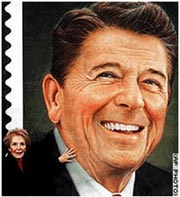 On
Wednesday, February 9, 2005, hundreds of Americans began licking a president's
portrait then passing it along to family, friends, and even strangers.
On
Wednesday, February 9, 2005, hundreds of Americans began licking a president's
portrait then passing it along to family, friends, and even strangers.
This peculiar honor goes to the nation's 40th president, Ronald Reagan, with the release of the latest commemorative postage stamp from the U.S. Postal Service (USPS).
Since 1847, when adhesive postage stamps were first officially issued in the United States, portraits of presidents and others who have made significant contributions to American life have since been featured on the nation's stamps.
On the very first official adhesive stamps issued, President George Washington and Benjamin Franklin, the first Postmaster General, were portrayed.
The U.S. Postal Service has been delivering mail to and from Americans for more than two centuries, since it was initially established as the Post Office Department in 1775 to carry communications between Congress and the armies.
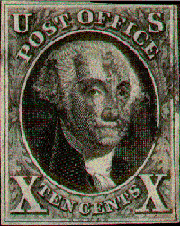 Today,
the USPS serves over 140 million homes and businesses.
Today,
the USPS serves over 140 million homes and businesses.
The postal service is the second oldest federal department or agency of the United States, but acts as an independent establishment of the Executive Branch. It operates like a business, and the revenue generated from selling postage is generally what keeps the service running.
For this week's lesson, you'll be exploring the art of stamps, as well as the history and impacts of this important service.
The Art of the Stamp
Let's get started by visiting the National Postal Museum in Washington, D.C. Here, your first stop is the Art of the Stamp gallery.
Dive into the Artwork section, to find out who suggests the subjects to be featured on stamps and who chooses the final artwork.
Read about some of the Stamps with a Story, along with those stamps that celebrated or commemorated people and events related to Arts and Entertainment and Athletics.
 Why
do you think these people and events were chosen to be depicted on our
stamps?
Why
do you think these people and events were chosen to be depicted on our
stamps?
Of course, other stamp subjects have come from American History, the American Scene, and American Legends.
In what ways have the artists used real images of the people or events to create the final products? How have these contributed to establishing our "national memory"?
Aside from historical references and those related to people, subjects including Love, Flora and Fauna, Science & Technology, and Water, Land and Air, have often been used.
What is it about those types of subjects that would inspire people to collect these stamps? In what ways have the stamp artists, including Norman Rockwell, captured the essence of their subjects?
Neither Snow Nor Rain....
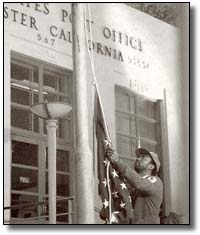 "Neither
snow nor rain nor heat nor gloom of night stays these couriers from
the swift completion of their appointed rounds."
"Neither
snow nor rain nor heat nor gloom of night stays these couriers from
the swift completion of their appointed rounds."
That phrase, engraved on the outside of a Post Office in New York, has become the most well-known, yet still unofficial, motto of the U.S. Postal Service.
The phrase was actually a translation of an ancient Greek text describing the Persian system of mounted postal carriers around 500 B.C.
Although the system of mail carrying in the United States isn't quite that old, it has gone through an amazing evolution over its two-hundred-plus-year history.
Let's explore this evolution through a few of the National Postal Museum's Exhibits, starting with Binding A Nation.
Explore the topics and key objects in the gallery, including those related to Starting the System, The Post and the Press, The Expanding Nation, Moving West, The Pony Express, and A Nation Divided
What challenges did the postal service face in meeting the needs of the growing nation? How did delivery systems change over time as the population spread and technologies improved?
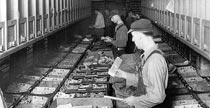 Next,
browse through the exhibits that illustrate the importance of the postal
service to Customers
and Communities, about how the system developed for
Moving the Mail, and The
Art of Cards and Letters.
Next,
browse through the exhibits that illustrate the importance of the postal
service to Customers
and Communities, about how the system developed for
Moving the Mail, and The
Art of Cards and Letters.
In what ways did the need for secure and reliable mail delivery shape transportation systems? How did service in urban areas compare with that in rural areas?
How do you think personal connections and business operations would have developed differently if mail service never existed? What are and what have been some of the specific challenges of delivering mail during wartime?
In what ways does the postal service affect your own life? How do you and others you know use the USPS to stay in touch with loved ones, do business, or complete other important correspondence?
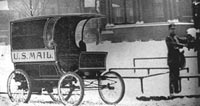 How
exactly is your mail delivered to you? For letters that you want to
send to others, are they picked up by your letter carrier, do you drop
them off in a mail box near your home, or do you have to take them to
your local post office?
How
exactly is your mail delivered to you? For letters that you want to
send to others, are they picked up by your letter carrier, do you drop
them off in a mail box near your home, or do you have to take them to
your local post office?
Before leaving the museum, take the Postmaster's Challenge. See if you can make it through to the top level, based on what you've learned. Some facts you may not have covered, but you can use the help of the postal clerk to make good guesses. If you don't make it past a level, you can always restart the game.
If you have time, you can explore even more information about the postal service at the USPS site detailing the History of the U.S. Postal Service.
You can also learn about international postal delivery at the ThinkQuest site, World Mail.
Newspaper Activities
In current issues of The Salt Lake Tribune, find articles about the postal service or stamps. Are there any changes being made to your local, regional, or statewide service? Has a new post office been built somewhere? If a new stamp has been issued, why was the subject selected and who created the artwork? Has the price of stamps increased? If so, by how much and for what reason? Have any new regulations on "junk mail" been created? Also, look for stories about how letters have affected or are affecting people's personal lives. This includes any letters related to historical events, people, or places, as well as those exchanged between military personnel and their families or friends.
© Copyright 2005
Learners Online, Inc.
